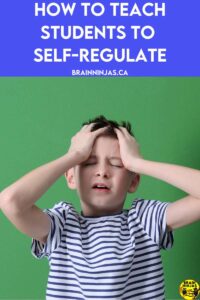
What does it mean to self-regulate? Well, the obvious answer means for students to keep their feelings in check. But that’s a bit misleading. It implies that students need to squish down their feelings. Emotional regulation is a skill that students need to be taught. It does not come naturally for everyone.
Students who are having a hard time with self-regulation often appear to be disengaged, rude, helpless or otherwise frustrating for teachers. For many teachers, this means ramping up the WOW factor to try to entice students into wanting to learn. This might mean costumes, balloons, candy and confetti for math-but imagine if it could be something so much simpler?
How are you feeling today?
Imagine all you might learn from your students with a simple question as they enter the room in the morning. It’s so simple. In fact, it’s so simple many people forget to check in with their students.
Being able to identify, express and regulate emotions is a difficult skill in a society that aims for happy HaPpY HAPPY! Thanks to a little Pixar movie, parents are starting to warm up to the idea that sadness is not a villain.
Everyone needs to be able to feel, express and control their emotions and as teachers, we are on the front line. To be clear-controlling emotional regulation does not mean stopping feelings from happening. It means finding healthy ways to deal with them.
We use these Feelings Check pages. You can find them in our Resource Library, or we can send them to you when you sign up for our email list.
Let’s Take a Look at a Case Study
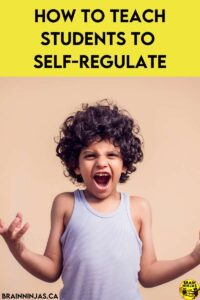
Little Janie is angry. She rips up her math book, throws it on the floor and stomps out of the room, slamming the door in the process.
First, assure the rest of your class that Janie is ok. She’s obviously struggling with her feelings right now, so let’s give her some time to calm down and sort them out.
This tells students that Little Janie is not in trouble for having feelings. It also gives them an example of a strategy they might use if they are ever feeling well. It also lets students know that acting like that is not going to get immediate attention (hopefully deterring students from joining in).
Back to Little Janie
We went to search for her and from a distance said, “Janie, I can see you are angry. When you are calmer, we can talk about it.”
And then walk away. Let the student learn to calm down. Do not threaten, punish, shame or engage in negative behaviour. (Also, ensure the child is safe before leaving them alone). There will be time to sort out the reasons for the behaviour later. There is no point in talking about everything at that moment because the student is far too upset and angry to talk rationally.
Your school might have a policy about students being in the hall. In our school, we have an arrangement that students can be in the hall, but everyone keeps an eye on everyone. This strategy does not work if your child is a runner. In that case, arrange a designated spot where the child can work out their feelings.
In the meantime…
We asked the class to ignore the behaviour and be supportive and kind when Little Janie returned. She did, about five minutes later, and we let her take her place in the class not pointing out or discussing what had happened, but welcoming her back instead.
After the lesson, we moved to a quieter space without an audience full of classmates and asked, “How are you feeling?”
She spilled the beans so we let her get it all out, reminding her in a calm quiet voice that we were listening. Kids will spill it, and no matter how irrational their reasons are-validate their feelings. She felt angry and frustrated and we responded with, “Yes, you were very angry, but we cannot rip books and slam doors no matter how angry we get. What can you do differently when you get angry next time?”
Teach Your Students About Feelings
We tend to overlook “soft skills” like mental health and wellness because we have so many other things pulling at our attention. Teaching students about feelings is very important if you want your students to be able to develop emotional regulation skills and take care of their mental health.
We have an entire post about why health class is important: Stop Overlooking Health Class if you want more information.
Some students struggle with feelings because they don’t have the words to describe how they are really feeling. We wrote an entire unit about how to teach the vocabulary needed for your students to be able to express how they are feeling.
The Managing Feelings Unit is set up to help your students in Grades 4-6 through a variety of activities that teach students how to describe their feelings and what to do with them once they know what they are feeling. You can find the Managing Feelings Unit in our TPT Store ($USD) and BN Shop ($CAN).
We also have a version written for younger students in our Managing Feelings Unit for Grades 1-3. This also deals with vocabulary and self-talk, but it is written at a level for younger students. The Managing Feelings and Social Emotional Learning Unit is available in our TPT Store ($USD) or BN Shop ($CAN).
There is also a Managing Feelings Word Wall Set which will save you the time of coming up with a huge list of words. The set is editable digitally so you can add any words you need. You can find the Managing Feelings Word Wall Set in our TPT Store ($USD) and BN Shop ($CAN).
It turns out that in our case study, Little Janie was frustrated because she didn’t understand how to do division. She just needed help expressing her frustration in a healthy way. She cannot be punished for not understanding division. Correct the behaviour, but punishing her, in this case, will only result in more issues with division later.
This is why teaching students to identify and express their feelings is so important to emotional regulation.
Once They Know Their Feelings, Now What?
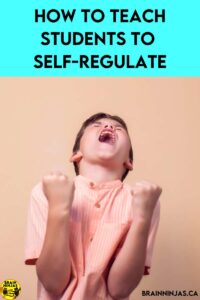
Once students are aware of their feelings, they can start to look at what is causing the feeling. Knowing the cause can help alleviate the feeling. For example, knowing that Janie was struggling with division was enough to lower the level of frustration.
We practice using positive self-talk with our students. This means we help students acknowledge their feelings and then think about how to turn that around so it doesn’t stop them from continuing with their day.
An example of this might be Janie saying, “I am really frustrated with division.” With positive self-talk, her statement becomes, ” I am really frustrated with division, but I am lucky that I have extra time to practice and keep trying.”
Self-talk doesn’t eliminate the feeling, but it allows students to see there will be a positive in the future. Some students gravitate towards this naturally, and others need lots of practice. This just comes down to personality and whether the student is an optimist or a pessimist.
Come up with a plan before you need it.
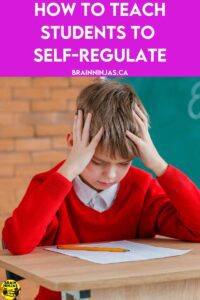
Frustration Breaks
We use code words to allow students to take a frustration break. A frustration break needs to be asked for BEFORE a blowout. Students learn when to ask. We have arrangements with other teachers to let students walk it off in the hall. Even just taking a walk to the water fountain or washroom can be enough to let a student reset their emotions.
Calm Boxes
We have a calm box that any student is allowed to use. It contains a few fidget tools, some play-dough, and colouring pages, and it is placed in a quiet space. Only one student is allowed to use it at a time, and we have a few basic rules about when it can be used (not during a test). We don’t worry about students using it to avoid doing work because students need to request its use. They learn quickly how and when we’ll allow it.
Individual Plans for Students
Little Janie has an EFP (Emergency Frustration Plan). It includes a code word. We have learned she needs to know about changes in advance whenever we can. This helps her accept the changes to her routine. She has some of her own calming tools that no one else has access to, but she also doesn’t use the calming box.
Model
Self-regulation doesn’t need you to be a disciplinarian. It needs you to be a teacher who shows students how to respond to feelings. You should share how you are feeling (and the why, too) with student-appropriate examples. Include the self-talk so students can see that everyone — even adults — has to manage their feelings.
Your Classroom Environment
Use your classroom environment to help with your self-regulation. Offer opportunities for quiet. Turn off the lights. Put on meditation music. Allow students to have a quiet moment (especially when they’ve just come back in from a crazy recess).
Transitions
One of our best ways to transition from exciting activities like gym or lunch to learning activities is to turn off the lights and invite students to put their heads down on their tables or desks. We read to them. We read very quietly in a calm voice. They mimic our tone, so it’s important for your voice and body language to match the level you want them to match.
Classroom Culture
Create a culture in your classroom that allows students to talk about their feelings. This can be done through class meetings, checking in with your students, talking about your own feelings, being proactive about possible feelings (like changes to routines or when the school nurses come to do vaccinations) and using the vocabulary for emotional regulation whenever possible.
We even created an Emotional Regulation Bingo Game to continue to have conversations about self-regulation with our students. You can find this resource in our TPT Store ($USD) and BN Shop ($CAN).
Breathing
What if students could self-regulate on their own? This video by Julie Bayer Salzman and Josh Salzman highlights the importance of just breathing. Take a breath…everyone.
Stretching
Sometimes we just need a great stretch to help reset our brains to get ready for more work. Show students a few different stretches they can do and use anytime.
Finger/Hand Tracing
A calm activity we learned was tracing shapes in the air slowly and calmly. We also have pictures of shapes on the wall that students are encouraged to touch and trace with their fingers. A task like this usually calms the brain and allows students to sort out their feelings before returning to work.
Noise-Cancelling Headphones
Students who know they need quiet need to know there are options for quiet working time. We allot certain times of the day for quiet work, but we also offer students noise-cancelling headphones they can use any time.
Wiggle/Move/Bike Time
We have several seating options for students who need to move. They learn to use these tools to help get their wiggles out so they can get back to work. We have wiggle cushions, Hokki stools and several under-the-desk pedal bikes. After the novelty wears off, the students who actually need to move do it, while the others don’t bother.
We have a few standing desks that don’t have chairs. Students who like to stand while they work are given that option.
A few of our chairs have rubber bands tied to the legs so students can push and pull on them.
We even had a little trampoline in our classroom for a while. Students could take off their shoes and then jog on the spot for one minute. We just left a timer beside the trampoline. Students were allowed to use it when it was independent work time.
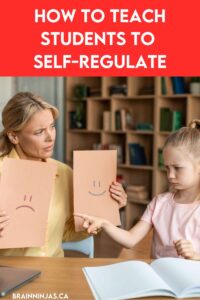
Once students can trust you (and their classmates) with their feelings, many of the dramatic behaviours tend to go away (well, many of them). They need to know they can take care of their needs, and the more they can learn to do this on their own without prompting, the better.
When students know their feelings will be heard and validated, they will feel confident. They need to know that others feel the same way. It’s part of what makes them human.
If you’re looking for some books and other resources to use to help your students learn skills for emotional regulation, you might want to read our posts The Secrets to Teaching Social Emotional Learning That Will Work for Kids or Make Wellness a Priority in Your Classroom.
What other emotional regulation strategies do you use to help your students learn to self-regulate? Let us know in the comments below.

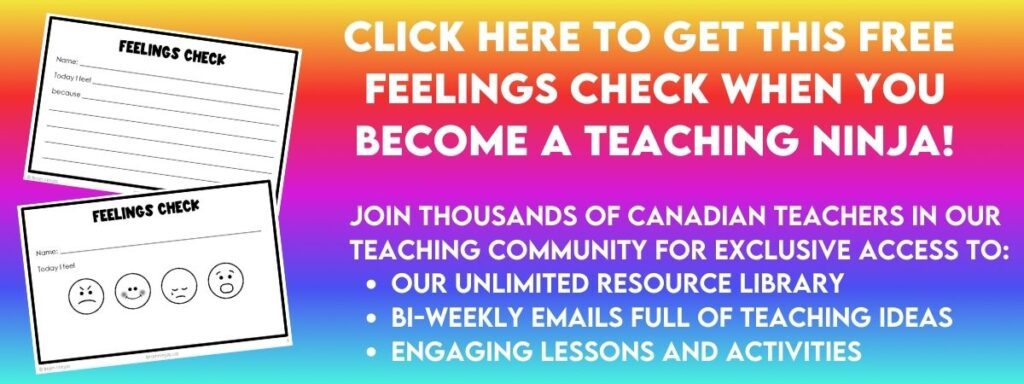






Do you have the feelings wheel in tpt? The one it looks like the kids can color in by zones? It’s at the top of this article….would love to use it with my students!
Hi Sarah, The wheel is one of the first activities in our Managing Feelings Unit found in in our Teachers Pay Teachers store. https://www.teacherspayteachers.com/Product/Social-Emotional-Learning-Activities-1436074